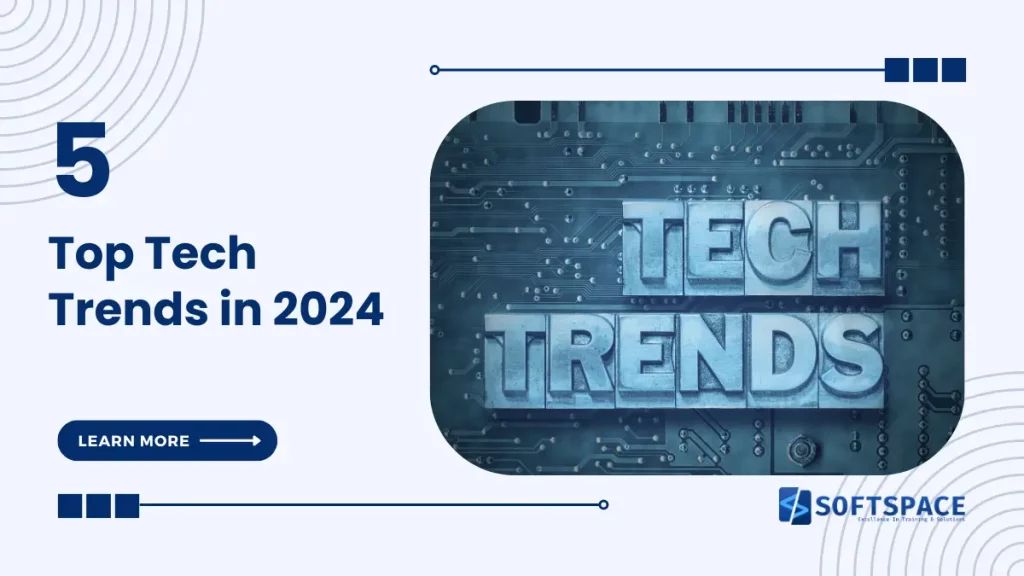Welcome to the future! Technological advancements continue to reshape our world, and 2024 will undoubtedly be a pivotal year. In this article, we will explore five tech trends in 2024 that are set to make a massive impact in the coming future. From artificial intelligence revolutionizing industries to the rise of virtual reality, these trends hold the potential to transform the way we live and work.

Top Tech Trends in 2024
Trend #1: Artificial Intelligence (AI)
Artificial Intelligence (AI) has been a buzzword for quite some time now, but in 2024, we can expect it to become an integral part of our lives. AI is no longer just about machines performing tasks; it has evolved to mimic human intelligence and decision-making processes. From self-driving cars to personalized shopping experiences, AI is set to revolutionize various industries.
In healthcare, AI-powered systems can analyze patient data to provide accurate diagnoses and personalized treatment plans. This will lead to more efficient and effective healthcare delivery, saving lives and reducing costs. Additionally, AI can enhance customer service by using natural language processing to understand and respond to customer queries, improving satisfaction and loyalty.
While the potential benefits of AI are immense, there are also ethical considerations to be addressed. Ensuring transparency, accountability, and fairness in AI algorithms will be crucial to prevent bias and discrimination. As AI becomes more prevalent, it is essential to strike a balance between technological advancements and human values.
Trend #2: Internet of Things (IoT)
The Internet of Things (IoT) refers to the network of interconnected devices that collect and exchange data. With over 50 billion connected devices predicted by 2024, the IoT will have a profound impact on our daily lives. From smart homes to connected cars, the IoT will enhance communication, automation, and efficiency in various aspects of our lives.
In healthcare, IoT devices can monitor patients remotely, allowing for early detection and intervention in case of emergencies. Smart cities can use IoT sensors to optimize traffic flow, reduce energy consumption, and improve the overall quality of life for residents. Moreover, IoT devices can revolutionize supply chain management by providing real-time data on inventory levels, demand patterns, and logistics.
However, with the increasing number of connected devices, security and privacy concerns become paramount. Protecting personal data and ensuring the integrity of IoT networks will be crucial to prevent cyber-attacks and unauthorized access. As the IoT continues to evolve, policymakers and industry leaders must collaborate to establish robust security measures.
Trend #3: Augmented Reality (AR) and Virtual Reality (VR)
Imagine stepping into a virtual world where you can explore new places, interact with digital objects, and even collaborate with others, all from the comfort of your own home. This is the promise of augmented reality (AR) and virtual reality (VR), technologies that are set to transform the way we experience and interact with the world around us.
AR overlays digital information onto the real world, enhancing our perception and understanding of our environment. From navigation apps to interactive gaming experiences, AR has already made its mark. In 2024, we can expect AR to become even more immersive and integrated into our daily lives.
VR, on the other hand, transports us to entirely virtual environments, creating a sense of presence and immersion. From gaming and entertainment to training simulations and virtual meetings, VR has the potential to revolutionize various industries. In 2024, we can expect VR to become more accessible and affordable, opening up new opportunities for businesses and consumers alike.
However, challenges such as motion sickness, limited content, and high costs still need to be addressed for AR and VR to reach their full potential. As these technologies continue to evolve, we can expect more innovative applications and improved user experiences.
Trend #4: Blockchain Technology
Blockchain technology, best known as the foundation of cryptocurrencies like Bitcoin, is set to disrupt traditional financial systems and offer new opportunities for secure transactions. In 2024, we can expect blockchain to become even more prevalent, revolutionizing industries beyond finance.
One area where blockchain is making waves is supply chain management. By providing a decentralized and transparent ledger, blockchain can track the journey of goods from the source to the consumer, ensuring authenticity, reducing fraud, and improving traceability. This has significant implications for industries such as food and pharmaceuticals, where safety and provenance are critical.
Moreover, blockchain has the potential to revolutionize digital identity management. With blockchain-based identity systems, individuals can have more control over their personal data, reducing the risk of identity theft and fraud. This can transform various sectors, including healthcare, finance, and government services.
As blockchain technology continues to evolve, scalability and interoperability will be key challenges to overcome. Additionally, regulatory frameworks will need to adapt to ensure consumer protection and prevent misuse of this powerful technology.
Trend #5: 5G Technology
With the rise of smart devices and the increasing demand for high-speed connectivity, 5G technology is set to become a game-changer. In 2024, we can expect 5G networks to be widely available, offering faster speeds, lower latency, and greater capacity.
The benefits of 5G extend beyond faster download and upload speeds. It will enable the widespread adoption of technologies such as autonomous vehicles, smart cities, and the Internet of Things. With its low latency, 5G will facilitate real-time communication and enable applications that require instant responsiveness, such as remote surgery and augmented reality gaming.
However, the rollout of 5G comes with its own set of challenges. Building the necessary infrastructure, ensuring network security, and managing spectrum allocation will require significant investments and coordination between governments, telecommunications companies, and other stakeholders.
Salary range for the top tech trends in 2024
Salary ranges can vary depending on factors like experience, location, and specific company, but here’s an estimate for the mentioned trends in India (as of April 18, 2024):
Artificial Intelligence (AI):
- AI Researcher: ₹ 8-15 Lakhs per annum
- Data Scientist: ₹ 6-12 Lakhs per annum
- Machine Learning Engineer: ₹ 7-14 Lakhs per annum
- Natural Language Processing Engineer: ₹ 9-16 Lakhs per annum
- Computer Vision Engineer: ₹ 8-15 Lakhs per annum
Internet of Things (IoT):
- IoT Architect: ₹ 10-18 Lakhs per annum
- IoT Developer: ₹ 5-10 Lakhs per annum
- IoT Security Specialist: ₹ 7-12 Lakhs per annum
- IoT Product Manager: ₹ 8-14 Lakhs per annum
- Embedded Systems Engineer: ₹ 6-11 Lakhs per annum
Augmented Reality (AR) and Virtual Reality (VR):
- AR/VR Developer: ₹ 6-11 Lakhs per annum
- 3D Artist: ₹ 4-8 Lakhs per annum
- AR/VR UX Designer: ₹ 5-9 Lakhs per annum
- AR/VR Software Engineer: ₹ 7-13 Lakhs per annum
- AR/VR Content Creator: ₹ 4-8 Lakhs per annum
Blockchain Technology:
- Blockchain Developer: ₹ 7-12 Lakhs per annum
- Blockchain Security Engineer: ₹ 8-14 Lakhs per annum
- Blockchain Solutions Architect: ₹ 12-20 Lakhs per annum
- Cryptocurrency Analyst: ₹ 5-9 Lakhs per annum
- Smart Contract Developer: ₹ 8-15 Lakhs per annum
5G Technology:
- 5G Network Architect: ₹ 12-18 Lakhs per annum
- 5G Software Developer: ₹ 6-11 Lakhs per annum
- 5G Testing and Validation Engineer: ₹ 7-12 Lakhs per annum
- 5G Operations Engineer: ₹ 8-14 Lakhs per annum
- Radio Frequency (RF) Engineer: ₹ 7-13 Lakhs per annum
Implications of these Tech Trends on Businesses and Consumers
The convergence of these tech trends will have far-reaching implications for both businesses and consumers. For businesses, embracing these technologies can lead to increased efficiency, reduced costs, and improved customer experiences. Companies that fail to adapt may find themselves left behind in an increasingly digital world.
Consumers, on the other hand, will benefit from more personalized and convenient experiences. From personalized healthcare treatments to immersive entertainment, these tech trends will enhance our daily lives in ways we can only imagine. However, it is essential to address issues such as data privacy, security, and accessibility to ensure that these benefits are accessible to all.
How to Stay Updated with the Latest Tech Trends
With technology evolving at breakneck speed, staying updated with the latest tech trends can be a challenge. Here are a few tips to help you stay ahead:
- Follow reputable tech news sources and blogs: Stay informed by following authoritative sources that cover the latest developments in technology.
- Join professional networks and communities: Engage with like-minded professionals and experts in the field to exchange insights and stay updated.
- Attend industry conferences and events: Conferences and events provide an excellent opportunity to learn from industry leaders, network, and gain valuable insights into emerging trends.
- Engage in continuous learning: Embrace a growth mindset and invest in continuous learning. Take online job-oriented courses, participate in webinars, and explore new technologies to expand your knowledge.
- Experiment and explore: Embrace a hands-on approach by experimenting with new technologies and exploring their potential applications. This will help you gain practical insights and stay ahead of the curve.
Challenges for Adopting These Tech Trends in 2024
While these tech trends hold immense potential, several challenges and considerations need to be addressed for successful adoption:
- Cost: Implementing these technologies can be costly, especially for small businesses. It is essential to carefully evaluate the return on investment and consider scalability before embarking on adoption.
- Skills Gap: As new technologies emerge, there may be a shortage of skilled professionals who can effectively leverage these technologies. Upskilling and reskilling the workforce will be crucial to bridge this skills gap.
- Security and Privacy: With the increasing reliance on technology, ensuring the security and privacy of data becomes paramount. Robust security measures and privacy regulations need to be in place to protect sensitive information.
- Ethical Considerations: As AI becomes more prevalent, ethical considerations such as bias, transparency, and accountability need to be addressed. It is crucial to ensure that these technologies are developed and deployed responsibly.
- User Experience: For these technologies to gain widespread adoption, they need to provide a seamless and intuitive user experience. Designing user-friendly interfaces and considering user feedback will be key to successful implementation.
Conclusion
As we look ahead to adopt the tech trends in 2024, it is clear that technology will continue to shape our world in profound ways. From artificial intelligence and the Internet of Things to augmented and virtual reality, these tech trends hold immense potential to transform the way we live and work. However, with great potential comes great responsibility.
It is crucial to address challenges such as security, privacy, and ethical considerations to ensure that these technologies benefit society as a whole. So, buckle up and get ready for the future. The tech revolution is just getting started!

13+ Yrs Experienced Career Counsellor & Skill Development Trainer | Educator | Digital & Content Strategist. Helping freshers and graduates make sound career choices through practical consultation. Guest faculty and Digital Marketing trainer working on building a skill development brand in Softspace Solutions. A passionate writer in core technical topics related to career growth.



